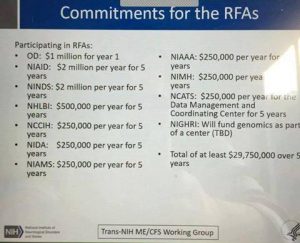NIH issued no RFAs last week, but we have plenty to talk about after Dr. Vicky Whittemore’s presentation at the CFS Advisory Committee on Friday. Dr. Whittemore’s announcement was simultaneously welcome and disappointing.
During her update to the committee on NIH activities, Dr. Whittemore revealed how much money the long delayed RFAs will offer:
 The RFAs should total approximately $29,750,000 over five years. Dr. Whittemore said that this money is in addition to the expected investigator initiated proposals that we’re familiar with. She also said that it was challenging to get these Institutes to commit these dollars.
The RFAs should total approximately $29,750,000 over five years. Dr. Whittemore said that this money is in addition to the expected investigator initiated proposals that we’re familiar with. She also said that it was challenging to get these Institutes to commit these dollars.
It is notable that ten of the twenty-seven NIH Institutes are contributing money, plus a one-year contribution from the Office of the Director. The bulk of the money is coming from the National Institute of Allergy and Infectious Diseases and the National Institute of Neurological Diseases and Stroke. This is not surprising, as most grant funding for ME comes from these two Institutes. The National Center for Advancing Translational Sciences is restricting its contribution to the RFA for the Data Management Center, which is a bit disappointing because NCATS is among the leaders at NIH in incorporating stakeholder input into its funded studies. It would be nice to take advantage of the existing infrastructure there.
What does this mean in terms of how the money will be used? The payout should look something like this:
- Year 1: $6,750,000
- Year 2: $5,750,000
- Year 3: $5,750,000
- Year 4: $5,750,000
- Year 5: $5,750,000
This money will be divided between the RFA for the Data Managing Center and the RFA for the Research Consortium. I think Dr. Whittemore expected two to three sites would be funded, plus the Data Center (which does not necessarily have to be at another institution). I’m guesstimating $1.6 million to each of three sites and $750,000 for the Data Center, per year.
Is this good? Well, yes, in that something is better than nothing. And also yes, because NIH is making a five year commitment. Based on Dr. Whittemore’s comment at the IACFS/ME meeting that 2016 funding for ME would be doubled in 2017, I had personally predicted an RFA total of $7 million maximum for one year. That was a little high, it turns out, but I did not expect the five year commitment.
But this is also disappointing. Measured by the overall NIH yardstick, $6 million a year for a research consortium on a disease that costs our economy $20 billion a year is not even peanuts. NIH gave $7 million a year to Fragile X Research Centers (Fragile X is a rare genetic disorder). NIH’s Autism Center of Excellence Program is funded with about $20 million per year. And the huge NIH Pain Consortium offers myriad funding opportunities, including a number of research center programs.
I am deeply concerned that some of the Institutes are contributing only grudgingly. Furthermore, I think it’s unlikely that there will be additional RFAs for at least two or three years while we wait for the Consortium to get going and bear fruit. The successful Consortium applicants better knock this out of the freaking park. We need highly economical management of projects that produce extremely promising interim results. That’s the only way we can secure bigger commitments quickly.
Furthermore, we need researchers to submit proposals outside the RFA mechanism. Lots and lots of proposals. Again, the only way we will see an increase in dollars is if more proposals are successful. I know grant writing is a pain in the butt. I’ve watched four members of my family go through the process repeatedly over the years. But you can’t win if you don’t play the game. I would love to see the number of applications double in 2017 and then double again in 2018. That demonstration of interest would send a loud message to NIH that we are “shovel ready.”
I suspect that some (many?) advocates may want to focus on thanking NIH for this investment, and not say anything negative about it. But here’s the thing: when you are starving to death on a cup of rice a day, the addition of another cup of rice sounds like a banquet, but you are still going to starve to death.



I know how hard Vicky Whittemore worked to get this. And I so appreciate her. But it stinks of “begrudgingly given” so terribly that I have to hold my nose to swallow and accept that this is all we will get in RFAs for the next few years. Crumbs. These government officials who hate us, patient-blame us, psychologize us and ignore us are killings my friends. Literally. The numbers of suicide and ME-related deaths are growing and each year it will be worse. Brace yourself, friends. And fight back.
The NIH funded P2P seemed deliberately designed to produce this kind of result–get as many bureaucracies involved as possible to put a huge drag on the output. The mountain laboured, and brought forth a mouse, as the saying goes. Ah well, we need to be modestly grateful for the crumbs, and hope that the active work going on in several centres now will continue and finally make some real dents in our situation. And many thanks again, Jenny, for both keeping the pressure on and letting us know what is going on, even if it is disappointing.
Disappointment was my initial response, but after all these years it is almost a knee jerk response so I wanted to sit back and digest the information a little bit. Your blog post and the input of others helps to frame this yet I still end up with mixed emotions. I am grateful for the 5 year commitment, and the consortium, but is this enough to actually fund those projects to get any work done? I don’t know. I understand that they wanted to demonstrate that they are truly dedicated to this but by spreading the cost over 5 years they can spread out the commitment. What it does though is guarantee that the work produced with this money is done internally and controlled by them. That is a little disappointing. I come to believe that privately funded research centers seem more motivated to find our answers and the NIH may do some solid work which will in the end be more readily absorbed by the medical community and disseminated more effectively, but the bureaucratic pace with which it is done will not match the private sector’s progress.
Thank you Jennie for your assessment!
You are right in saying some progress is better than none; but, I’m still pretty disappointed in this dollar amount. Having been a Clinical Research Coordinator for 17 years prior to developing ME/CFS, I know what is takes to fund clinical trials. While not wanting to sound ungrateful, in the grand scheme of things, this is nothing more than “chump change” (even more so when compared to what we asked for and deserve). It’s just a shame the very ones who have the least amount of energy to fight have to or continue suffering dire consequences.
Thank you for breaking this all down for us, Jennifer. I appreciate all that you and so many others are doing to inform and advocate for recognition, validation and some, as you so eloquently stated, “freaking” help!
Thanks for your work keeping the pressure on and keeping us informed so efficiently Jennie. From this side of ‘the Pond’, the amount of money you’re talking about seems vast! 🙂 So it’s good to have someone who really knows the system, keeping track and bringing us down to earth.
Jennie, how much and what is “the expected investigator-initiated proposals”? (I am not sure I am familiar with that terminology. Is it the usual $5-6 million the NIH funds for ME/CFS per year? If not, how is that any better than what ME/CFS has been given by the NIH on average?
Thank you for your help in understanding this & for keeping us informed.
Yes, I was referring to the typical funding per year in grants to investigators.
Hi Jennie,
Thank you very much for the funding information regarding the RFAs for the research and data centres: $29,750,000 over 5 years.
Could you advise if the funds for individual investigator proposals are the $15 million announced a while ago? That replaces the traditional $5 million/year, correct? My crap memory makes this difficult to keep straight. Thanks so much for explaining!
Thank you very much to Dr. Vicky Whittemore for your hard work in securing this new funding. Your speaking for our community is wonderful!
Although a funding improvement, it’s possible a budget of $1.6 million/year for each research centre could disappear into administration costs. When you look at what big research projects such as the ones at Columbia, and the Open Medicine Foundation are doing, and the level of funds they need, I wonder how far $1.6/annum can stretch. Granted, the fabulous researchers in this field have accomplished much on their shoe string budgets, but come on folks at NIH, does this paltry rate of funding have to continue? Especially, compared to funding levels for less prevalent diseases, with less impact on quality of life.
This overall level of funding, and especially the $250,000 from some of the institutes definitely looks begrudging, as you say, Jennie. And, it still signals the erroneous belief that ME is psychological. The gap between what actually goes on for PWME, and the level of government assistance is still sadly lacking to put it mildly. And, significantly stepping up research funding is not all we need!
While researchers are applying for these funds, we need the entire health care field, from top to bottom, educated with the correct information about ME. And fast! We need the Canadian Consensus Criteria for ME adopted:
http://www.mefmaction.com/images/stories/Medical/ME-CFS-Consensus-Document.pdf (And, we don’t need this document re-hashed and shelved for another decade before its put into use!)
If the health care field was much more cognizant of the serious, complex, biological nature of ME, hopefully a proper standard of care would flow from this education. The Canadian Consensus Criteria would go long way in teaching this.
As it stands right now, and has for 3 decades, it’s open season on PWME. Anyone in the health care field with access to a medical file for a PWME, may feel entitled to abuse and neglect that person. With proper medical education this would hopefully abate.
There continues to be such enormous gaps in the “health care” for PWME. And, it appears to remain the case, although extremely unfair, the ME community must continue to fight!
Thank you very much, Jennie, for giving us this information.
$15 million was never announced or promised. It was a loose estimate that Dr. Whittemore made at the IACFS/ME meeting. This figure of $15 million is likely the total of the RFAs plus the total of the usual grant spending.
Regarding administration costs, NIH always puts a limit on that in RFAs. The notice will spell out exactly how much can be spent on overhead and indirect costs. So my guess of $1.6 million will be split between indirect costs (overhead) and direct costs (research).
Hi Jennie,
Thanks for your explanation. I guess it’s still a wait and see re the actual overall total per year for RFAs, plus the individual grant spending.
Good to know there is a ceiling for admin costs. In the past, I know institutions have used admin costs as a slush fund that has eaten up significant funding amounts.
Thanks again for the info!
This is a joke. I doubt if 5 million a year will be adequate for even one center of excellence. The five year commitment, the tiny amounts from most of the institutes, and the delay in organizing the RFAs are very loud messages that this is all we will get for the next five years, so don’t even bother to ask for more.
This blatant discrimination is prohibited by Section 504 of the Rehabilitation Act of 1973 [1]
“No otherwise qualified individual with a disability in the United States … shall, solely by reason of her or his disability, be excluded from the participation in, be denied the benefits of, or be subjected to discrimination under any program or activity receiving federal financial assistance or under any program or activity conducted by any Executive agency”
The public record is chock-a-block full of evidence that we have been excluded from and denied the benefits of NIH’s research programs and CDC’s education programs. The difficulties in accessing and participating in the recent CFSAC meeting also appears to violate Section 504.
While the feds have conveniently excluded themselves from the Americans With Disabilities Act, the Rehabilitation Act was specifically aimed at the federal government and all agency programs. That means they can be sued under Section 504 – at least in theory.
[1] https://en.wikipedia.org/wiki/Section_504_of_the_Rehabilitation_Act#Essence_of_the_Section
My question would be is this in lieu of or in addition to the $6 million they usually give us each year?
In addition.
Well, it’s good to know that I will finish my Pride’s Children mainstream trilogy with a CFS main character WELL before any research money does us any good. /sarcasm
If it takes off more, I can contribute some funds!
I hope someone does an end run somewhere, and figures it out sooner than forever, because with this paucity of research funding, the better researchers are going to read the handwriting on the wall, and go elsewhere. There are much better-funded diseases where they can make their mark. Going with us is like rearranging the deck chairs on the Titanic so someone can give a little talk on icebergs.
And the model of a character with a significant disability who manages life anyway will remain – for me to write from experience instead of hindsight, which I would have much preferred.
I agree with what’s being said, frustration, disappointment, anger, etc.
I don’t begrudge any disease being funded because illnesses affect people and no one should suffer from medical and research neglect.
But we have waited for decades and our time is way overdue. I’m hoping the university labs doing research will come up with an answer and treatment. The government has let us down for years. So, I’ll wait but I won’t hold my breath.